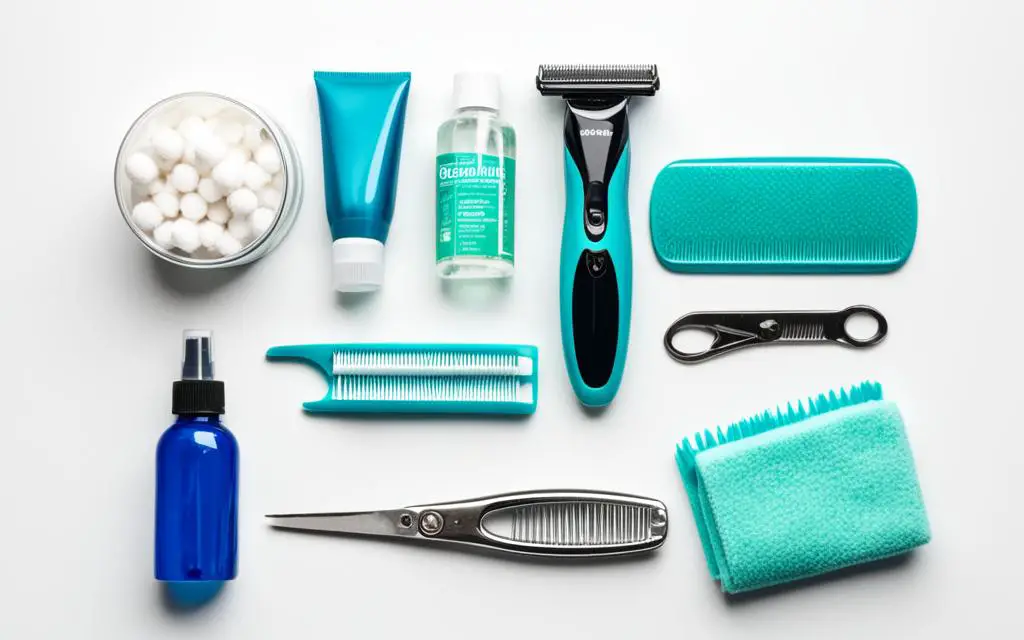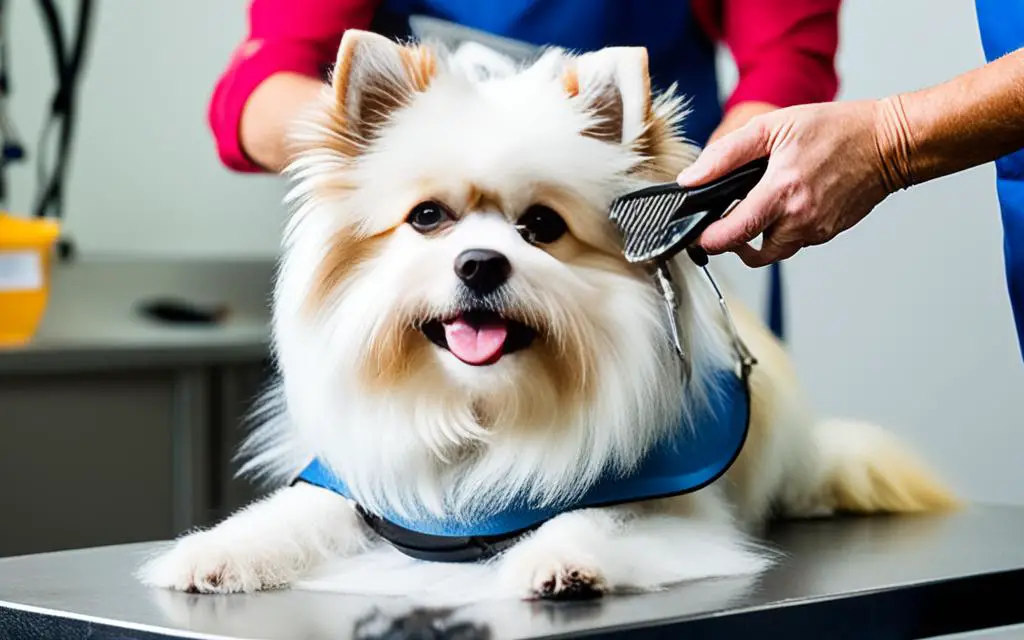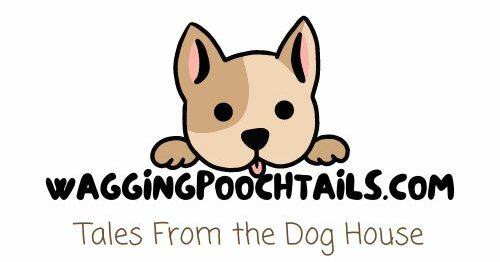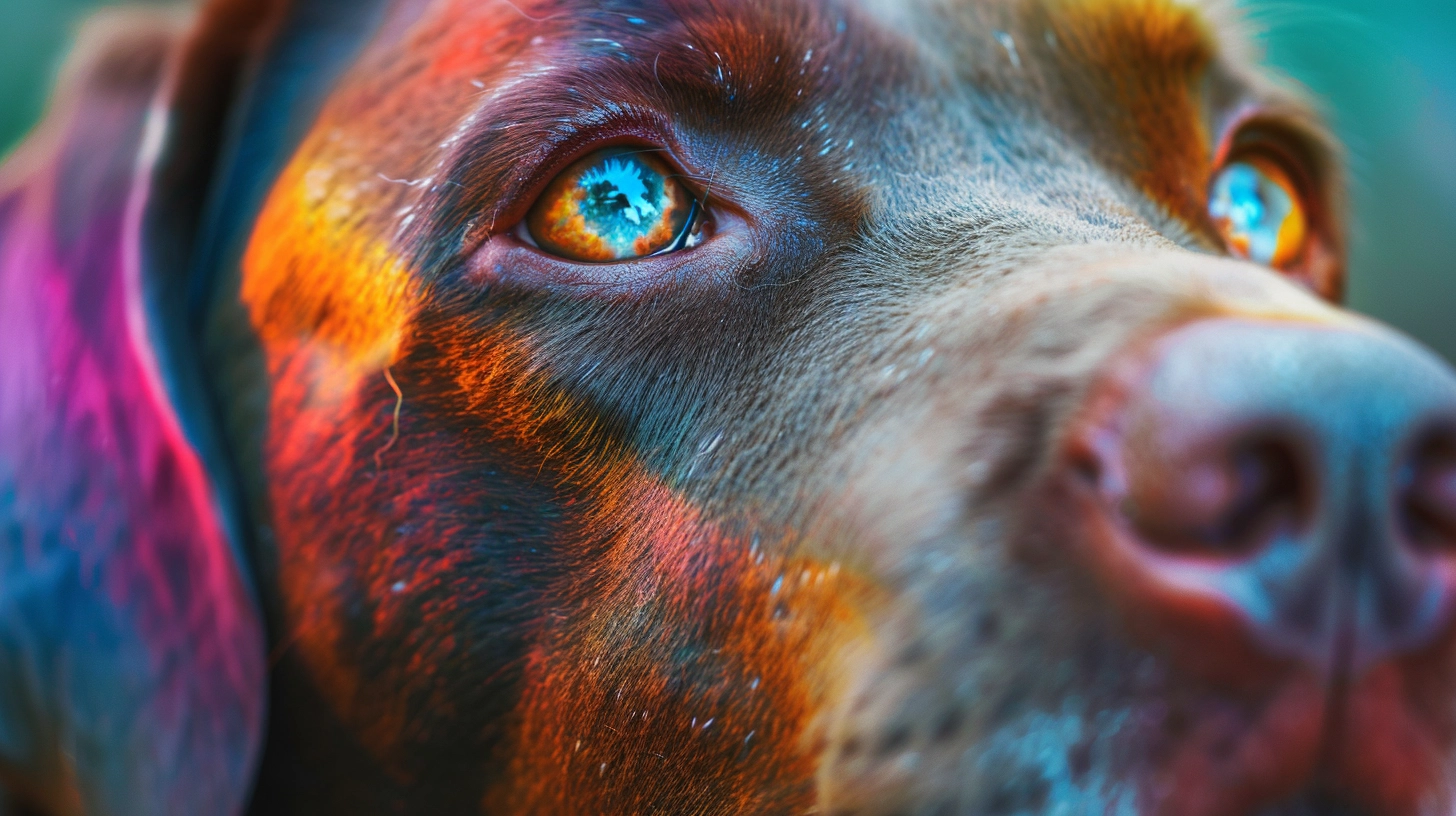Being a dog owner brings a unique joy. Our furry friends fill our lives with laughter and love. Yet, looking after them is a big job. One important part is grooming. Keeping our dogs groomed is essential for their looks and health.
If you’re new to dog ownership, you might wonder how to groom your dog. You may not know how to trim nails, clean ears, or brush teeth. It’s okay to feel unsure. This article will help you. We will show you how to make grooming safe and stress-free for you and your pet.
Key Takeaways:
- Regular grooming tasks such as nail trimming, ear cleaning, and teeth brushing are crucial for your dog’s overall health.
- By learning how to safely perform these grooming tasks, you can prevent health issues and save on future veterinary expenses.
- Establishing a grooming routine that suits your dog’s specific needs is essential.
- Having the right grooming tools on hand makes the grooming process much easier and more effective.
- Remember, patience, care, and positive reinforcement are the keys to a successful grooming experience.
Cleaning Your Dog’s Ears
It’s key to start a routine for your dog’s ear cleaning to stop ear infections. Dogs with floppy ears or a lot of ear hair are more prone to getting infections. This happens because of dirt, moisture, and wax building up. Puppies might get ear infections from mites. Teaching your dog to stay calm during cleaning is vital. You can clean your dog’s ears safely with an ear cleaner and cotton balls, following the instructions here.
Dogs use their hearing to understand the world, so ear health is very important. If we don’t take care of their ears, they could be in pain, feel discomfort, or even lose their hearing. Cleaning their ears regularly removes dirt and wax. This stops the buildup that can cause ear infections.
The Importance of Ear Cleaning for Dogs
“Keeping your dog’s ears clean is crucial, especially for those prone to infections. Clean ears can stop discomfort and avoid costly vet visits. It’s a simple but effective part of keeping your dog’s ears healthy.”
To clean your dog’s ears right, use a dog-friendly ear cleaner. Don’t use products made for humans, as they can harm your dog’s ears. Follow this guide to clean the ears:
- Gently lift your dog’s ear flap to show the ear canal.
- Put a few drops of ear cleaner into the ear canal. Avoid putting the applicator too far in.
- Massage the base of the ear to spread the cleaner and loosen debris.
- Let your dog shake their head to get rid of the loosened debris.
- Use a cotton ball or pad to gently wipe the visible dirt, wax, and cleaner from the ear. Be careful not to go too deep into the ear canal.
- Do the same for the other ear, if needed.
While regular ear cleaning is needed for most dogs, some with naturally clean ears might not need it as often. Check with your vet to know how often to clean your dog’s ears.
Including ear cleaning in your dog’s grooming routine can stop ear infections and keep their ears clean and healthy. Always use ear cleaning products made for dogs, and ask a vet if your dog seems to have ear discomfort or infection. Taking care of your dog’s ears is part of keeping them happy and healthy.
Brushing Canine Teeth
Brushing your dog’s teeth is key for their dental health. Brushing two to three times a week stops plaque and tartar. These can lead to gum disease and dental problems.
Start brushing when your dog is young. This gets them used to it early. To brush your dog’s teeth well, follow these steps:
- Get your dog used to the toothbrush and dog toothpaste by letting them sniff them first.
- Brush with the toothbrush at a 45-degree angle in small circles. Focus on the teeth’s outer parts.
- Then, gently brush the inside parts of their teeth and the back molars.
- Always be patient and reward your dog to make it a positive experience.
Choosing the right toothpaste and dental chews
It’s crucial to pick dog-specific toothpaste. Human toothpaste has harmful ingredients for dogs. Dog toothpaste tastes good to make brushing fun for your pet.
Dental chews help keep your dog’s teeth clean, too. They help remove plaque and tartar by chewing. They’re a good addition to brushing.
Talk to your vet for toothpaste and dental chew recommendations for your dog.
| Toothpaste | Features | Price Range |
|---|---|---|
| Merrick Fresh Kisses | Natural ingredients, textured dental treats | $10-$15 |
| Virbac C.E.T. Enzymatic Toothpaste | Enzymatic action, poultry flavor | $8-$12 |
| Nylabone Advanced Oral Care | Triple-action formula, peanut flavor | $6-$10 |
| Petrodex Enzymatic Toothpaste | Enzymatic action, poultry flavor | $5-$8 |
Looking after your dog’s teeth doesn’t require much effort. Regular brushing and dental chews keep their teeth clean and healthy. This will help avoid dental issues.
Nail Trimming Made Easy
Keeping your dog’s nails short is vital. Long nails can lead to discomfort, infections, and even joint problems. Yet, many dog owners struggle with nail trimming. The good news? With the right tools and approach, trimming can be easy for you and your pet.
Teaching Your Dog to Be Comfortable
It’s important to make your dog okay with nail trimming. Start slowly to get them used to it:
- Let your dog check out the nail trimmers. Give them treats for being curious.
- Gently hold your dog’s paw and show them some love for letting you. This step gets them okay with paw handling.
- Do a “paw targeting” exercise. Reward them for touching your hand with their paw to build more comfort.
- Get your dog used to the trimmers’ sound by clipping them without cutting nails. Keep the treats coming for calm behavior.
Trimming Your Dog’s Nails
Now that your dog is ready, here’s how to cut their nails safely:
- Pick the right trimmers for your dog. Your vet or groomer can recommend whether to use guillotine, scissor, or grinder style.
- Find a spot with good light and have treats ready for your dog.
- Hold your dog’s paw gently and spot the quick—the nail’s pink part with blood vessels.
- Keep the trimmers parallel to the nail. Trim little bits to avoid the quick.
- Cut the tip smoothly. Reward your dog for staying still.
- If you can see the quick in light nails, great. If not, trim little by little.
- If you cut the quick and it bleeds, stay calm. Use styptic powder to stop it. Call your vet if it doesn’t stop.
Make nail trimming positive. If your dog gets scared, pause and try later. Being consistent, patient, and positive makes it easier.
“Regular nail trimming is necessary to prevent overgrown nails that can cause discomfort and infections in your dog.”
| Nail Trimmers Comparison | Pros | Cons |
|---|---|---|
| Guillotine-style | – Easy to use – Provides clean cuts | – Not suitable for large dogs or thick nails – Blade may need replacement over time |
| Scissor-style | – Provides better control – Suitable for all dog sizes | – Requires strength to make cuts – Blade may become dull over time |
| Grinder-style | – Minimizes risk of cutting the quick – Smooths rough edges | – May cause noise-related stress – Requires acclimatization process |
Choose the best nail trimmers for your dog and yourself. Always focus on safety and don’t rush. Happy trimming!
Basics of Brushing
Dog grooming tools are vital for keeping your pet’s fur healthy. Brushing is good for dogs with any hair type. Whether their coat is short and smooth or long and silky, gentle care is the best.
Brushing your dog has many upsides. It removes loose fur, keeping your home cleaner. This matters a lot for dogs that shed a lot.
Brushing spreads natural oils on your dog’s skin, preventing dryness. It also stops knots and mats, making them comfortable. This avoids any hurt from pulling their hair.
Start brushing your dog slowly and with care. Let them sniff and look at the brush first. Giving them praise and treats makes them like the brush.
When you begin brushing, use soft strokes. Focus on areas with dense fur. Move the brush gently in circles to undo any knots without causing them pain.
To pick the right brush for your dog’s fur, check this table:
| Brush Type | Best for Hair Type | Key Features |
|---|---|---|
| Bristle Brush | All hair types | Soft bristles suitable for general grooming |
| Slicker Brush | Long-haired and curly-haired breeds | Fine, tightly packed bristles ideal for removing tangles and mats |
| Undercoat Rake | Double-coated and heavy-shedding breeds | Designed to remove loose undercoat and reduce shedding |
| Comb | All hair types | Teeth of varying widths for detangling and removing debris |
Brushing often is key to your dog’s care routine. The right tools and soft brushing keep your pet’s fur healthy, shiny, and smooth. Enjoy grooming!

Prevention is Key
Keeping your dog clean and groomed can stop many health problems. It can also cut down on vet bills. Make grooming a regular part of your pet’s life to keep them healthy and reduce future costs.
Pet hygiene practices are key. They include ear cleaning, nail trimming, teeth brushing, and coat brushing. These tasks keep your dog looking and feeling great. They also help catch health issues early, making treatment easier.
The Importance of Pet Hygiene Practices
Cleaning your dog’s ears regularly is vital. It stops ear infections, especially in dogs with long ears or a lot of ear hair. Use dog ear cleaner and cotton balls to carefully clean your dog’s ears. This helps your pet get used to ear cleaning.
Trimming your dog’s nails helps avoid pain and infections from too-long nails. It stops nails from breaking or becoming ingrown. Use dog nail trimmers and trim safely.
Brushing your dog’s teeth prevents dental issues like gum disease and tooth decay. Start a daily brushing routine with dog-specific toothbrush and toothpaste. Also, get regular dental check-ups at the vet.
Brushing your dog’s coat keeps it clean and shiny. It removes loose hair and prevents mats. Use the right grooming tools, like brushes and combs, for your dog’s coat type.
Veterinary Dental Cleanings
Along with home grooming, schedule regular dental cleanings for your dog at the vet. These cleanings remove plaque and tartar that brushing at home can’t reach. They prevent bigger dental problems, keeping your dog’s mouth healthy.
A Preventative Approach
Preventive care through grooming keeps your dog healthy. Clean ears, trimmed nails, brushed teeth, and groomed coats avoid health issues. They save you from costly vet visits later.
| Grooming Task | Recommended Frequency |
|---|---|
| Ear Cleaning | Weekly |
| Nail Trimming | Every 4-6 weeks |
| Teeth Brushing | Daily |
| Coat Brushing | Regularly, based on coat length and type |
Following these dog grooming tips ensures your pet stays healthy and happy. Regular grooming improves your relationship with your dog. It also helps their overall health.
What Grooming Tools Do I Need?
Getting the right grooming tools is vital for your dog’s care at home. Here’s a list of must-have grooming tools every dog owner should get:
- A rubber-bristled brush: Ideal for removing loose hair and massaging your dog’s skin.
- Wire slicker brush: Helps remove tangles and mats in your dog’s fur.
- Steel comb: Perfect for detangling and smoothing your dog’s coat.
- Dog nail clippers: Essential for safely trimming your dog’s nails to prevent discomfort and infections.
- Dog toothbrush and toothpaste: Promotes good oral hygiene and prevents dental issues in your dog.
With these tools, you can take care of your dog’s grooming needs. This way, they stay clean, healthy, and happy.
The Importance of Quality Grooming Tools
How Often Should I Groom My Dog?
Grooming your dog keeps them healthy and happy. How often you bathe, trim nails, and brush teeth depends on their coat type and needs.
Bathing short-haired dogs every 6-8 weeks is good. But, long-haired dogs might need baths every 4-6 weeks to avoid knots and mats.
Trimming your dog’s nails every 3-4 weeks is essential. If nails get too long, they can hurt your dog and lead to problems. Keeping nails short helps your dog walk comfortably and stay safe.
Daily teeth brushing is best for your dog’s dental health. It prevents plaque and keeps their mouth healthy. If daily brushing is hard, try for three times a week.
Adjust grooming based on your dog’s specific needs. Some might need more grooming because of health issues or their lifestyle. Talk to your vet for advice on what’s best for your dog.
Regular grooming makes your dog look great and feel great. It’s key to their happiness and health.
How Can I Groom My Dog’s Fur?
Trimming your dog’s fur at home needs care and caution. It’s crucial to make your dog comfortable with grooming tools like shears or clippers. Here’s a guide to ensure a smooth grooming session.
Gathering the Necessary Tools
First, gather the right grooming tools. You’ll need dog fur trimming shears or clippers, a dog hair cutting comb, and a dog grooming brush. These will help you trim your dog’s fur neatly.
Preparing Your Dog
Make sure your dog is relaxed before you start. Gently brush their fur to untangle any knots. Treats and praise will make them associate grooming with good things.
Focusing on the Face and Paws
The face and paws need extra attention during grooming. Use at-home dog grooming techniques for safely trimming around your dog’s eyes, ears, and muzzle. Trimming your dog’s face and paws also keeps them clean.
Trimming the Body and Tail
Trim your dog’s body and tail in small sections. Always comb the fur before cutting. Trim evenly, following your dog’s body shape. Remember to take breaks to keep your dog comfortable. Reward them with treats and praise.
Pro Tip: When unsure about how much fur to trim, it’s safer to trim a little at a time. This prevents mistakes.
Finishing Touches
After the trim, give your dog a final brushing. This removes any loose hairs. Their coat will look tidy and well-groomed.

These **at-home dog grooming** tips will help you keep your dog looking great. Always put your dog’s comfort and safety first. If you’re not sure about something, it’s best to seek professional advice.
| Benefits of Grooming Your Dog’s Fur at Home | Considerations |
|---|---|
| 1. Cost-saving alternative to professional grooming | 1. Proper training and handling are necessary to ensure your dog’s comfort |
| 2. Convenience of grooming on your own schedule | 2. Different dog breeds may require specific grooming techniques |
| 3. Builds trust and bonding between you and your dog | 3. Regular maintenance is required to keep your dog’s coat healthy |
Conclusion
Grooming is vital for your dog’s health and happiness. Safely trimming nails, cleaning ears, and brushing teeth prevents health problems. It keeps your dog feeling great.
Grooming keeps your dog clean and brings you closer together. It lets you find health issues early. Stick to a grooming routine that fits your dog’s needs.
Be patient and gentle when grooming your dog. Use positive words to make it a good time for both of you. Regular grooming is key to your dog’s health and long life.
FAQ
How do I safely trim my dog’s nails?
How do I clean my dog’s ears?
How do I brush my dog’s teeth?
How often should I trim my dog’s nails?
How often should I groom my dog’s coat?
What grooming tools do I need?
How often should I groom my dog?
How can I groom my dog’s fur at home?
Why is regular grooming important for my dog?
Source Links
- https://www.humanesociety.org/resources/how-groom-your-dog-home
- https://www.akcpetinsurance.com/blog/four-basic-grooming-skills-for-dog-owners
- https://www.nwitimes.com/life-entertainment/local/wellness/baths-nail-and-hair-trims-teeth-brushing-keep-your-dog-looking-and-feeling-its-best/article_3530a3f4-3208-11ee-b2c0-83b15b20102b.html





Leave a Reply